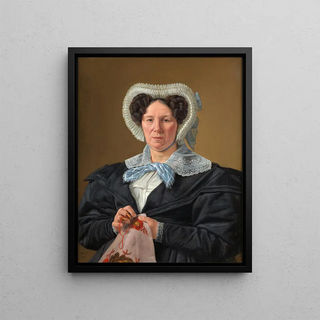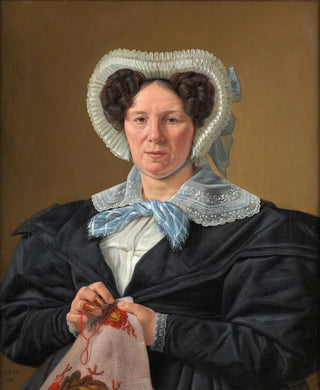Art print | The artist Mother Frederikke Eleonore Cathrine Rørbye née Stockfleth - Martinus Rørbye


View from behind

Frame (optional)
In the vast panorama of art history, certain works stand out for their ability to capture the very essence of their subjects, to weave connections between the past and the present. The art print Les artistes Mère Frederikke Eleonore Cathrine Rørbye née Stockfleth - Martinus Rørbye is a perfect example. This piece, imbued with delicacy and depth, immerses us in the intimacy of a couple of artists, revealing not only their talent but also the unique dynamic that united them. Through this representation, the artist manages to transcend a simple portrait to offer a reflection on art, creation, and human relationships.
Style and uniqueness of the work
The style of this art print is characterized by fine execution and meticulous attention to detail, typical of the Romantic movement of the 19th century. The chosen colors, both soft and vibrant, breathe new life into the depicted characters. Light plays a crucial role, illuminating the faces and creating a warm, intimate atmosphere. Every element of the composition is carefully arranged, allowing the viewer to feel an immediate connection with the subjects. The gestures of the characters, full of tenderness and complicity, demonstrate deep affection, while the subtly worked backgrounds add a narrative dimension to the whole. This art print does not merely depict; it tells a story, that of shared love and a common passion for art.
The artist and his influence
Martinus Rørbye, the artist behind this work, is an emblematic figure of Danish Romanticism. His journey, marked by travels across Europe, allowed him to enrich his artistic vocabulary and explore various influences. Rørbye was not only a talented painter but also a keen observer of his time. His work reflects a sharp sensitivity to emotional nuances, a trait that is evident in the portrayal of his companion, Mère Frederikke Eleonore Cathrine Rørbye née Stockfleth. Through her, Rørbye immortalizes not only a female figure but also the place of women in the art world.

Matte finish

View from behind

Frame (optional)
In the vast panorama of art history, certain works stand out for their ability to capture the very essence of their subjects, to weave connections between the past and the present. The art print Les artistes Mère Frederikke Eleonore Cathrine Rørbye née Stockfleth - Martinus Rørbye is a perfect example. This piece, imbued with delicacy and depth, immerses us in the intimacy of a couple of artists, revealing not only their talent but also the unique dynamic that united them. Through this representation, the artist manages to transcend a simple portrait to offer a reflection on art, creation, and human relationships.
Style and uniqueness of the work
The style of this art print is characterized by fine execution and meticulous attention to detail, typical of the Romantic movement of the 19th century. The chosen colors, both soft and vibrant, breathe new life into the depicted characters. Light plays a crucial role, illuminating the faces and creating a warm, intimate atmosphere. Every element of the composition is carefully arranged, allowing the viewer to feel an immediate connection with the subjects. The gestures of the characters, full of tenderness and complicity, demonstrate deep affection, while the subtly worked backgrounds add a narrative dimension to the whole. This art print does not merely depict; it tells a story, that of shared love and a common passion for art.
The artist and his influence
Martinus Rørbye, the artist behind this work, is an emblematic figure of Danish Romanticism. His journey, marked by travels across Europe, allowed him to enrich his artistic vocabulary and explore various influences. Rørbye was not only a talented painter but also a keen observer of his time. His work reflects a sharp sensitivity to emotional nuances, a trait that is evident in the portrayal of his companion, Mère Frederikke Eleonore Cathrine Rørbye née Stockfleth. Through her, Rørbye immortalizes not only a female figure but also the place of women in the art world.






